|
|
|
|
IT 1 |
“That seems to mean me all right”. |
|
|
|
|
|
|
|
Young Englishmen answered the call, for King and Country, and voluntarily joined the British Army. By early 1915 much of the regular army had been killed and were now replaced by the part-time volunteers of the Territorial Force and Kitchener's new volunteer army. The Kitchener recruitment campaign had proved to be very successful, as on September 1, 1914, over 30,000 men enlisted. With each day passing, thousands more were clamoring to be taken. Eventually, in January 1916, well before the Tommy’s Life cards were produced, conscription was introduced. |
|
|
|
|
|
|
IT 2 |
It’s funny how rotten your first uniform looks on you. You wonder how the other chaps manage to appear so smart. |
|
|
|
|
|
At the start of WW1 there was a shortage of khaki uniforms, an most new army units had to instead wear “Kitchener blue”, which was deeply unpopular (not least because it made new recruits look like bus drivers).
Some men spent hard-earned money in order to look extra smart. Soldiers would purchase special material that would be cut by a local tailor to their specific dimensions. |
|
|
|
|
|
|
IT 3 |
Getting your cup of tea in the morning was exciting as a battle. |
|
|
|
|
|
This dramatic card is reminiscent of the classical battle “Horatius at the Bridge”, here satirized in a 1905 illustration of William T Jerome, defending a bridge that leads to “honest government”. |
|
|
|
|
|
|
IT 4 |
First time you get out on the parade grounds and forgot to say “sir” to the Sergt-Major, the man with the big silver headed stick. |
|
|
|
|
|
|
|
Swagger sticks were most familiarly carried by military officers or more senior non-commissioned officers (in this case, a company sergeant major as signified by “The Crown” on his sleeve”). Some commissioned officers would carry swagger sticks when in uniform, whilst some Warrant Officers and Senior NCOs carried pace sticks instead.
A swagger stick sometimes incorporated a silver end featuring the regimental badge. |
|
|
|
|
|
|
IT 5 |
Remember the first rifle they gave you? How proud you were of it! Till you got a chance to poke it over the parapet at a German. |
|
|
|
|
|
|
|
The Lee-Enfield bolt-action, magazine-fed, repeating rifle was the main firearm used by the military forces of the British Empire and Commonwealth during the first half of the 20th century. It was the British Army's standard rifle from its official adoption in 1895 until 1957.
The parapet was the topmost part of the trench wall that pointed towards the enemy, typically lined with sandbags. |
|
|
|
|
|
|
IT 6 |
One time, just as I thought I was getting good at the game, my puttee became undone on parade. They made such a fuss about it I was afraid I would be ordered to be shot at dawn! |
|
|
|
|
|
|
|
A puttee, also spelled puttie, is the name, adapted from the Hindi patti, bandage (Skr. patta, strip of cloth), for a covering for the lower part of the leg from the ankle to the knee, consisting of a long narrow piece of cloth wound tightly and spirally round the leg, and serving both as a support and protection, worn especially by riders, and taking the place of the leather or cloth gaiter. |
|
|
|
|
|
|
IT 7 |
It was quite a trial the first pay parade; what with the smallness of the sum laid out for me, and the bigness of the job of stepping up to collect it! |
|
|
|
|
|
Soldiers were paid once a week, usually on a Friday afternoon. Where conditions permitted, troops attended a Pay Parade, presided over by the unit commander, at platoon or company level. Pay parades often had a lieutenant or captain in charge, assisted by one or two NCOs of the unit. Each soldier's name would be called out in alphabetical order along with the last three digits of his regimental number - "Mackain, 299!". The soldier would stamp his heel and shout back, "Sir!" or "Present!" then march smartly forward to the pay-table, salute, have his pay-book marked in the correct amount, receive his pay in cash handed from the NCO, salute again, and march back to his place.
 The officer here is a captain (three scallops and two rings on the sleeve). The officer here is a captain (three scallops and two rings on the sleeve). |
|
|
|
|
|
|
IT 8 |
You are a Trained Soldier as soon as you finish your firing course. It’s hard to shoot well at this time, on account of having so many to help you hit the bulls eye. |
|
|
|
|
|
No man could be sent to the front until he had passed the British army marksmanship test, a standard test that required the soldier to hit a target at 100 meters with 15 rounds. If he failed he was sent back and not allowed to go to war. Ammunition was in short supply so the men only got a few times to practice, however the instructors (usually old soldiers) often 'miscounted' and let men get though even if they had failed. The “mad minute” required a soldier to load and fire 15 rounds in 60 seconds.
Average training for the ordinary infantry soldier started at approximately 12 weeks, and by 1918 was down to about 6 weeks. Training was basic as most people already accepted orders, routine, manual labor, etc as the norm. The main areas of training were rifle and bayonet drill, small unit tactics and understanding the basics of trench warfare. |
|
|
|
|
|
|
IT 9 |
It was a thrilling moment that day, at tea time, when our lot were told off for the Overseas draft. |
|
|
|
|
|
Lieutenant-Colonel Winter (photo, right), a Second-Lieutenant in 1914, and a Captain in 1916, was involved in the enlistment process of the 23rd Royal Fusiliers. With his ledger-like book and his green-baize-covered table (see IT 7), he was a familiar figure to the soldiers. |
|
|
|
|
|
|
IT 10 |
Naturally, one writes a good many letters describing the many adventures one is shortly to experience. |
|
|
|
|
|
After training, troops where usually sent to a transit camp, here they would pick up further skills and specialist work if they demonstrated aptitude, (e.g. Heavy Infantry, Bomber, Pioneer, Signals, Dispatch, Medical, etc) and if picked out as a leader would often be taken and given additional training for NCO leadership. This would normally take another 4 weeks of training time and increased as technology improved over the 4 years of the War. Finally, they would be granted some leave, especially if they had a posting to France. |
|
|

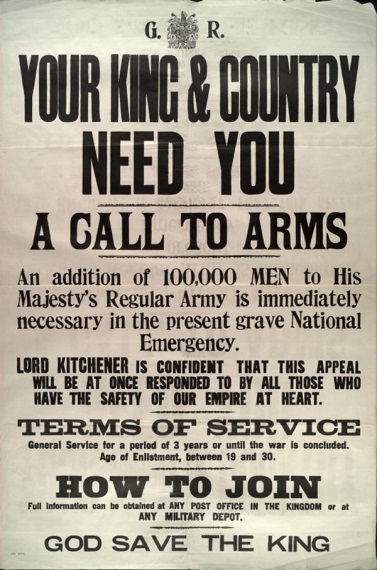
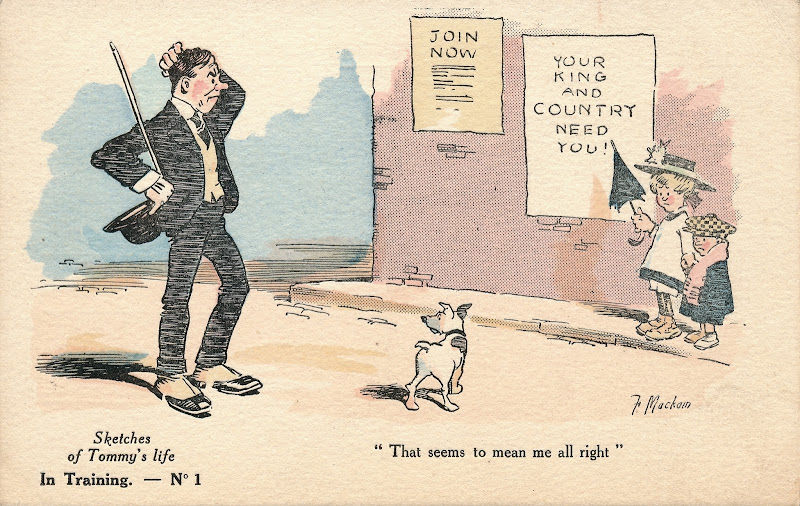




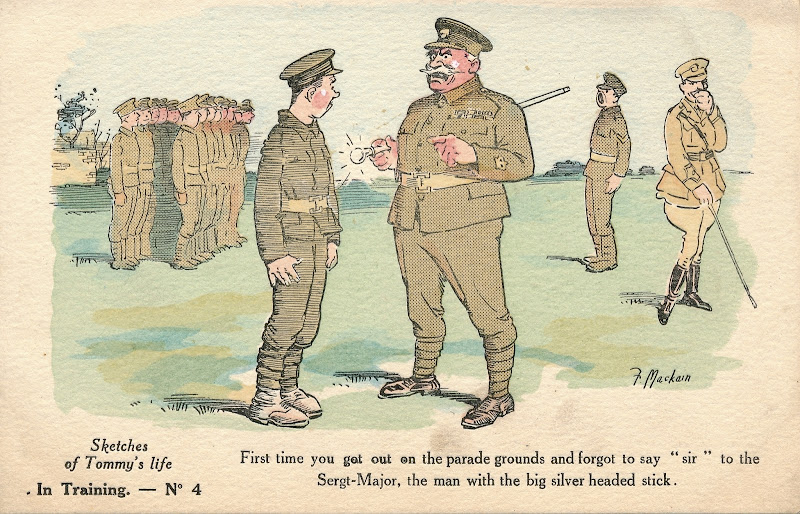
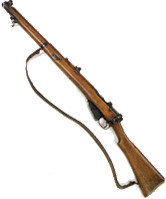



 The officer here is a captain (three scallops and two rings on the sleeve).
The officer here is a captain (three scallops and two rings on the sleeve).



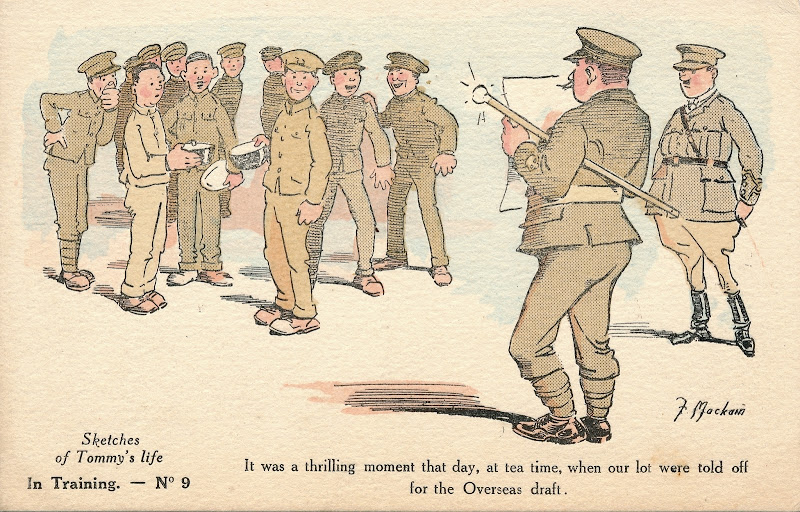

No comments :
Post a Comment